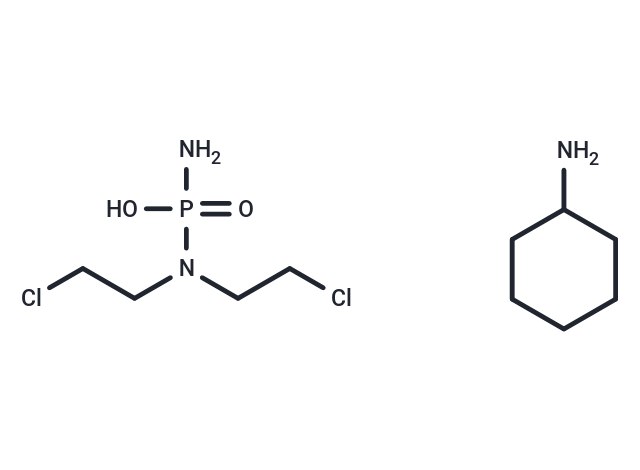Shopping Cart
Remove All Your shopping cart is currently empty
Your shopping cart is currently empty
Phosphoramide mustard cyclohexanamine is the active metabolite of cyclophosphamide, an alkylating agent that cross-links DNA strands, organizes cell division and causes cell death, and has antitumor activity.

| Pack Size | Price | USA Warehouse | Global Warehouse | Quantity |
|---|---|---|---|---|
| 1 mg | $199 | 7-10 days | 7-10 days |
| Description | Phosphoramide mustard cyclohexanamine is the active metabolite of cyclophosphamide, an alkylating agent that cross-links DNA strands, organizes cell division and causes cell death, and has antitumor activity. |
| In vitro | Phosphoramide mustard cyclohexanamine induces DNA cross-linking and damage in SIGC cells, reducing cell viability in a dose-dependent manner. Cell viability is significantly decreased at concentrations of 3 μM and 6 μM after 48 hours of exposure. Phosphoramide mustard cyclohexanamine induces DNA cross-linking and damage in SIGC cells, reducing cell viability in a dose-dependent manner. Cell viability is significantly decreased at concentrations of 3 μM and 6 μM after 48 hours of exposure. Phosphoramide mustard cyclohexanamine also elevates mRNA and protein expression of genes involved in DNA damage response (DDR), indicating activation of DDR pathways. also elevates mRNA and protein expression of genes involved in DNA damage response (DDR), indicating activation of DDR pathways. |
| In vivo | Administration of Phosphoramide mustard cyclohexanamine at 3-6 mg/kg in rats reduces bone marrow cell viability and induces DNA adduct formation and damage within 24-48 hours[1]. |
| Molecular Weight | 320.2 |
| Formula | C10H24Cl2N3O2P |
| Cas No. | 1566-15-0 |
| Smiles | O=P(O)(N)N(CCCl)CCCl.NC1CCCCC1 |
| Storage | keep away from direct sunlight | Powder: -20°C for 3 years | In solvent: -80°C for 1 year | Shipping with blue ice/Shipping at ambient temperature. | |||||||||||||||||||||||||||||||||||
| Solubility Information | H2O: 50 mg/mL (156.15 mM), Sonication is recommended. | |||||||||||||||||||||||||||||||||||
Solution Preparation Table | ||||||||||||||||||||||||||||||||||||
H2O
| ||||||||||||||||||||||||||||||||||||
| Size | Quantity | Unit Price | Amount | Operation |
|---|

Copyright © 2015-2025 TargetMol Chemicals Inc. All Rights Reserved.